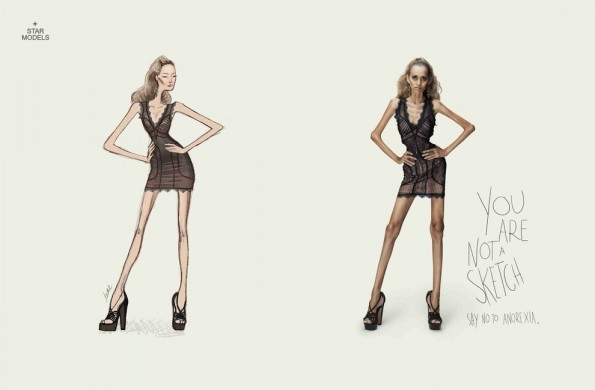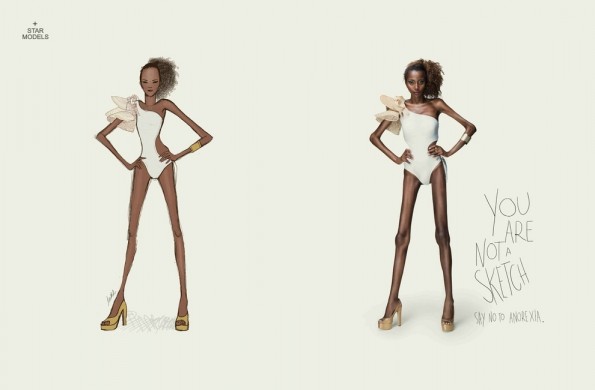A Brazilian modeling agency, Star Models, recently released a new series of anti-anorexia PSA advertisements. They illustrate one of the ways ultra-thin body ideals characterizing women’s bodies in the fashion industry today are institutionalized, or made part of the way we “do” fashion. Fashion sketches—the way that people communicate designs to one another—idealize these bodies, with their exaggerated proportions, long slender limbs, and expressionless faces. The PSAs place real women alongside the sketches, graphically altered to similar proportions, in order to problematize the ideal.
Star Models’ anti-anorexia ads call our attention to the dangerous aspects of adherence to industry ideals.
Sociology professors are constantly asking students to analyze what they might be taking for granted. One issue we take for granted is that the images on the left are what “fashion” looks like and ought to look like. That they are culturally recognizable as fashion sketches speaks to the ways in which hyper-thin feminine bodies are institutionalized at a fundamental level in the fashion industry today.
The Dove Evolution video—as a part of their “Campaign for Real Beauty”—vividly illustrates the work that goes into the production of advertisements. Using a time-lapse video depicting the diverse labor that goes into the production of an ad was a simple illustration of the impossibility of contemporary beauty ideals. Viewers are left thinking: “Of course we can’t look like that. She doesn’t even look like that.”
Star Models’ anti-anorexia ads promote a similar message, but also call our attention to the more dangerous aspects of adherence to industry ideals. Similar to depictions of what Barbie might look like as a real woman, altered images of dangerously thin models aside these sketches have a very different feel from the sketches they imitate.
WHAT IS BEING DONE ABOUT IT?
In 2007, the Council of Fashion Designers of America (CFDA) passed a Health Initiative in recognition of an increasingly global concern with the unhealthily thin bodies of models and whether/how to promote change in the industry. The CFDA is working to better educate those inside the industry to identify individuals at risk, to require models with eating disorders to seek help and acquire professional approval to continue working, to develop workshops promoting dialog on these issues, and more.


The CFDA’s Health Initiative, however, treats eating disorders as an individual rather than social problem. This allows the CFDA to obscure the role it might play in perpetuating cultural desires for the very bodies it purports to “help” with the Health Initiative.
Susan Bordo famously wrote about anorexia as what she termed “the crystallization of culture.” We like to draw firm boundaries between normality and pathology. But Bordo suggests that anorexia is more profitably analyzed as culturally normative than as abnormal. Similarly, Star Models’ PSAs play a role in framing the fashion industry as (at least partially) responsible for ultra-thin feminine body ideals. Yet, they arguably fall short of providing institutional-level solutions as the tagline—”You are not a sketch. Say no to anorexia.”—concentrates on individuals.
The CFDA’s focus on health initiatives and support for individuals suffering from anorexia, bulimia, and other eating disorders are critical aspects of recognizing issues that seem to plague the fashion industry. While this surely helps some individual women, the initiatives simultaneously avoid the cultural pressures (in which the fashion industry arguably plays a critical role) that work to systematically conflate feminine beauty with ultra-thin ideals. Similar to problems associated with focusing attention only on the survivors of sexual assaults (failing to recognize the ways that sexual violence is both institutionalized and embedded in our culture), these images simply illustrate that individual-level solutions are unlikely to produce change precisely because they fail to locate “the problem” and ignore the diverse social institutions and ideals that assist in its reproduction.
This post originally appeared onSociological Images, a Pacific Standard partner site.





